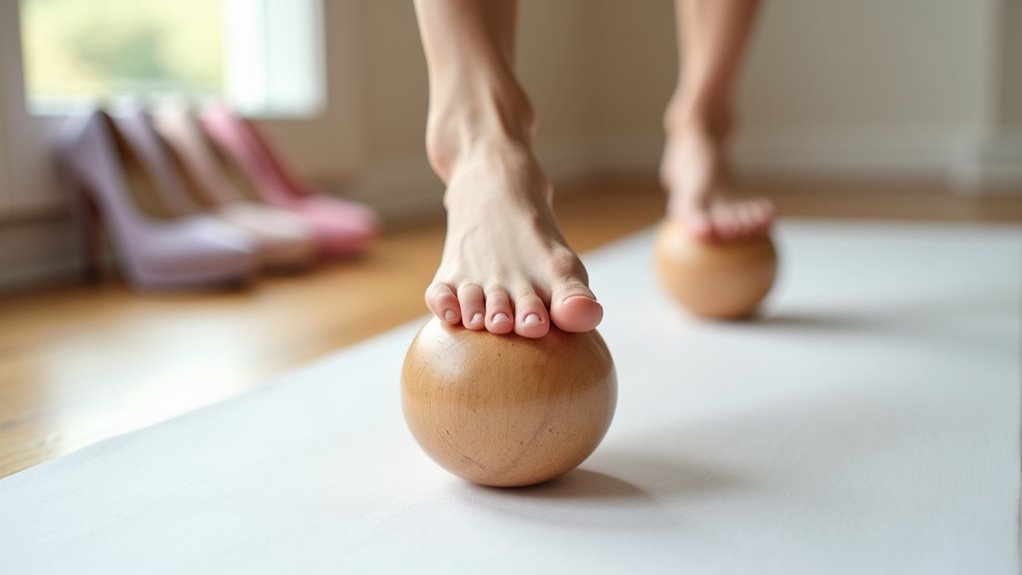There may be products. Products are independently selected by our editors. We may earn an affiliate commission from the links with no charge to you, example: as Amazon Affiliate.
When supermodel Naomi Campbell famously declared she could run in six-inch heels, she wasn’t just bragging – she’d spent years developing the foot strength necessary for such a feat. If you’re a high heel enthusiast, you’ll need more than just confidence to master your favorite stilettos; you’ll need targeted exercises to build resilient feet and ankles. While many focus on choosing the right shoes, it’s actually your foot strength that determines how gracefully you’ll move and how long you can stay comfortable in heels. Let’s explore the essential exercises that’ll transform your high heel experience.
Key Takeaways
- Daily toe exercises like marble pickups and toe raises strengthen intrinsic foot muscles essential for heel-wearing stability.
- Progressive ankle circles and heel raises build crucial ankle stability needed for comfortable high heel wear.
- Single-leg balance training improves overall foot strength and coordination while enhancing proprioception for heel walking.
- Resistance band exercises target specific foot muscles and gradually increase strength through controlled movements.
- Regular practice of foot bridges and dorsiflexion exercises strengthens arches and prevents common heel-related foot problems.
Understanding High Heel Impact
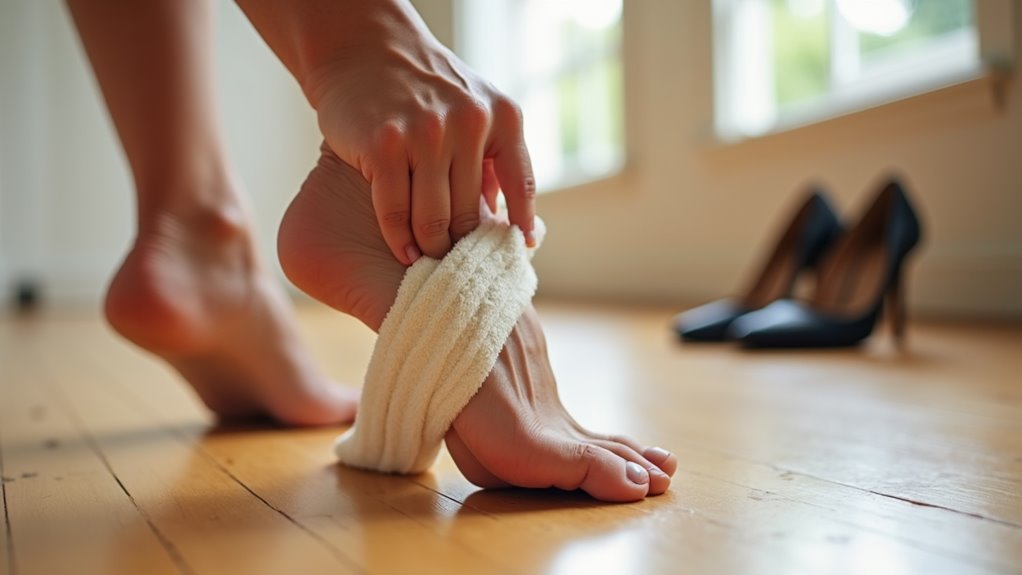
While high heels may elevate your style, they significantly alter your body’s natural biomechanics and can lead to serious foot problems over time.
When you wear high heels, you’re shifting up to 75% of your body weight onto the balls of your feet and toes, disrupting your natural walking pattern. Your feet weren’t designed to handle this uneven weight distribution, which explains why you might experience discomfort in the forefoot area.
The elevated heel position prevents your foot from striking the ground naturally, increasing pressure on your metatarsal heads and joints. This abnormal stress pattern affects not just your feet, but your entire skeletal alignment, potentially causing issues from your ankles to your lower back.
Understanding these impacts is crucial for making informed decisions about your footwear choices. Consider shoes with supportive heel design to help minimize discomfort and maintain better foot alignment.
Essential Foot Strengthening Exercises
To protect your feet when wearing high heels, you’ll need a balanced approach to foot strengthening that starts with basic exercises like toe raises and marble pickups.
As you build foundational strength, you can progress to more challenging resistance methods using resistance bands and weighted movements to further fortify your foot muscles.
You can easily incorporate a quick five-minute routine into your morning schedule by combining simple exercises like toe taps and towel scrunches while getting ready for the day.
Basic Strengthening For Beginners
Building strong, resilient feet begins with three fundamental categories of exercises: toe strengthening, arch conditioning, and flexibility training. You’ll want to start with simple toe raises and curls, gradually working up to more challenging moves like marble pickups and towel scrunches.
| Exercise Type | Beginner Move | Reps |
|---|---|---|
| Toe Strength | Toe Raises | 10-15x |
| Toe Strength | Toe Curls | 10x |
| Arch Support | Heel Raises | 10-15x |
| Flexibility | Ankle Circles | 30 seconds |
| Core Work | Golf Ball Roll | 2 minutes |
For best results, perform these exercises daily, focusing on proper form rather than speed. Start with seated exercises before progressing to standing ones, and always work within your comfort zone to prevent strain or injury.
Advanced Resistance Training Methods
Once you’ve mastered the basic foot exercises, advancing to resistance training methods will dramatically enhance your foot strength for high heel wear.
Focus on the short foot exercise by contracting your intrinsic muscles to raise your arch while bringing the ball of your foot toward your heel.
Incorporate ankle stability work through single-leg heel raises and dorsiflexion movements. You’ll want to master the foot bridge by placing your heel and big toe on elevated surfaces while maintaining proper arch position.
For targeted toe strength, practice big toe abduction and resistance band exercises.
Don’t forget to progressively overload your exercises by adding external weights or increasing duration.
Remember to combine strength with flexibility training, ensuring you’re building both power and mobility for comfortable heel wearing.
Daily Quick Exercise Routine
While high heels may look glamorous, maintaining foot strength requires a consistent daily exercise routine. You’ll want to focus on key exercises like calf raises, performing 4 sets of 25 repetitions to strengthen your lower legs and improve balance.
Incorporate toe tapping and ankle circles throughout your day to enhance flexibility and circulation. You can do these exercises while sitting at your desk.
Practice toe lifts and short foot exercises to build intrinsic muscle strength and arch stability. Don’t forget to include releves by rising onto your tiptoes without bending your knees.
For comprehensive foot conditioning, add bear squat to downward dog movements and ball exercises.
These will improve your ankle mobility, stretch your tendons, and strengthen the stabilizer muscles that support your arches.
Ankle Support Training
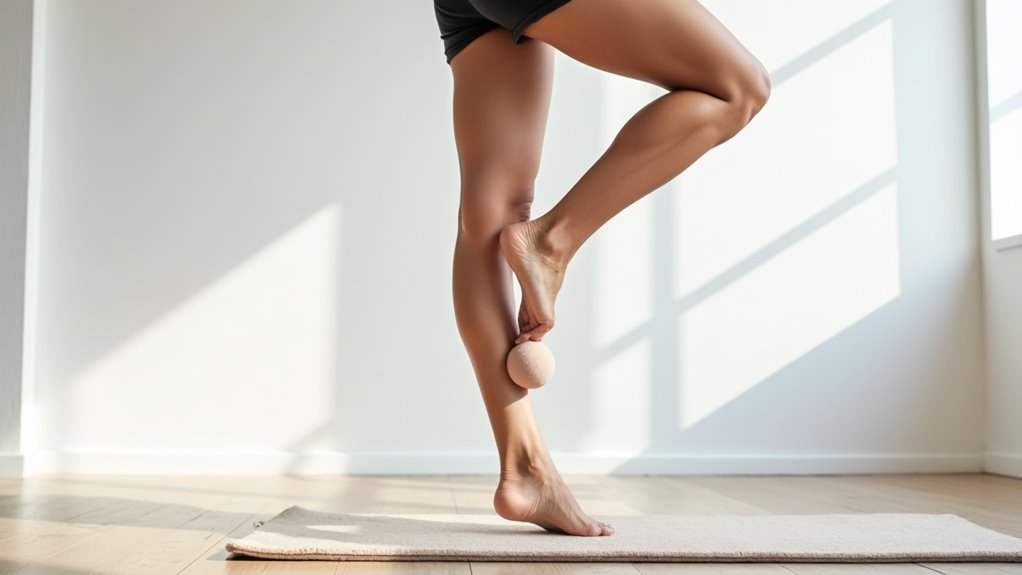
Because high heels can strain your ankles, proper support training is essential for preventing injuries and maintaining stability.
You’ll need to focus on exercises that strengthen the muscles around your ankle joint while improving flexibility and balance.
- Perform ankle circles in both directions to enhance mobility and prevent stiffness.
- Practice heel raises to build strength in your intrinsic foot muscles.
- Incorporate single-leg balance training to improve stability.
- Add resistance-based ankle flexion exercises for muscle development.
- Include toe-tapping and flexion movements to increase range of motion.
Remember to gradually increase the intensity of your exercises as you build strength.
Combine these movements with regular stretching to prevent muscle imbalances that can occur from wearing heels.
Consistent practice of these exercises will help you maintain strong, stable ankles while enjoying your favorite footwear.
These exercises are particularly important when wearing seasonal pumps that may have varying heel heights and designs.
Preventing Common High Heel Injuries
You’ll need to watch for early warning signs like persistent toe numbness, heel pain, or unusual tightness in your arches before they develop into serious injuries.
Your stretching routine should include toe spreads, calf raises, and ankle rotations to maintain flexibility and prevent strain on ligaments and tendons.
When soreness strikes, give your feet proper rest time, use ice therapy for inflammation, and consider switching to lower heels until you’re fully recovered.
Consult foot care products recommended by podiatrists to support your foot health and prevent future injuries.
Identifying Early Warning Signs
Recognizing early warning signs of high heel-related foot problems can prevent serious injuries and chronic conditions from developing.
When wearing high heels, you’ll want to pay attention to your body’s signals and take immediate action if you notice any concerning symptoms.
Watch for these key warning signs:
- Pain and swelling in the ball of your foot, which may indicate metatarsalgia
- Development of bunions or bunionettes near your toes
- Unstable ankles or frequent near-sprains while walking
- Ingrown toenails or persistent toe discomfort
- Burning sensation between your toes, suggesting possible neuroma
If you experience any of these symptoms, it’s time to reassess your footwear choices.
Consider switching to lower heels, using orthotic insoles, or alternating between heels and flats to give your feet adequate recovery time.
Proper Stretching Techniques
While high heels can make a bold fashion statement, proper stretching techniques are essential to prevent common foot injuries and maintain long-term foot health.
Start your daily routine with the water bottle stretch, rolling it under each foot for one minute to target your plantar fascia.
Follow this with the towel stretch, gently pulling your toes toward your body to lengthen tight muscles.
For calf flexibility, perform the wall-based heel stretch by pressing your front knee toward the wall while keeping your back leg straight.
Don’t forget the stair-based heel stretch – it’s particularly effective for Achilles tendon health.
Finally, use a tennis ball to massage your arches in circular motions, helping to release tension and improve blood flow.
Recovery After Soreness
After spending hours in high heels, proper recovery techniques can prevent long-term foot problems and minimize discomfort.
You’ll find relief by soaking your feet in warm water with Epsom salts for 15-20 minutes, followed by a gentle massage using lotion or foot cream. Focus on your arches and the balls of your feet, applying firm but controlled pressure to release tension.
- Elevate your feet to reduce swelling and improve circulation
- Use the Naboso Neuro Ball or similar massage tools to stimulate blood flow
- Perform ankle circles and toe stretches to maintain flexibility
- Practice relaxing poses like Virasana to stretch your quadriceps and ankles
- Schedule regular podiatrist visits for personalized care advice
These recovery methods will help maintain your foot health while allowing you to continue wearing your favorite heels comfortably.
Balance and Stability Workouts
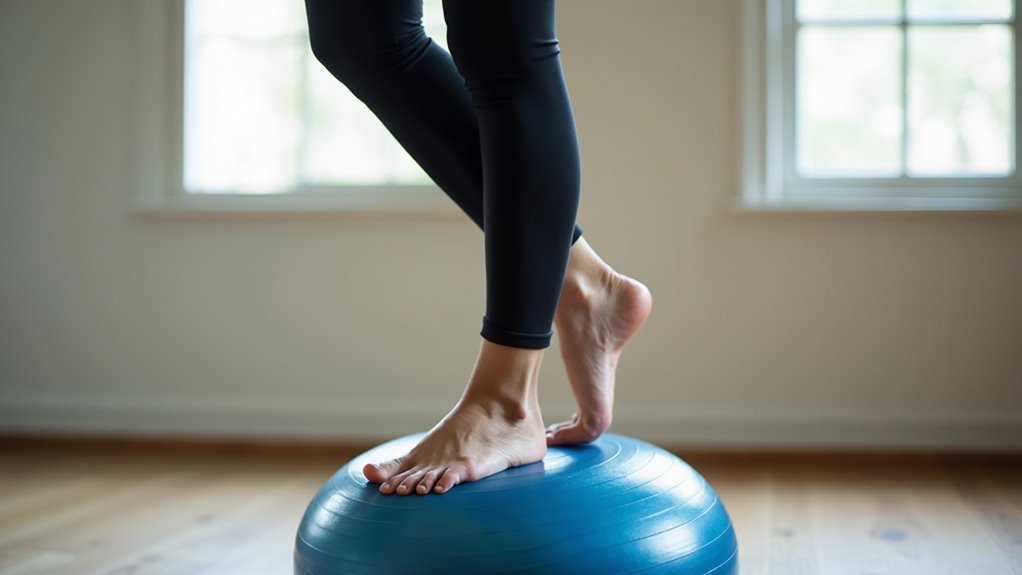
Before slipping into those stylish high heels, mastering balance and stability exercises can significantly reduce your risk of injury and improve your walking confidence. Start with heel raises while standing on the balls of your feet, then progress to single-leg balance holds, increasing duration as you improve.
Practice tandem walking by placing one foot directly in front of the other, as if you’re walking on a tightrope. This helps develop your proprioception and stability. Incorporate ankle dorsiflexion exercises to strengthen the muscles around your ankles, and don’t forget the short foot exercise – it’s crucial for building intrinsic foot strength.
For optimal results, combine these exercises with proper posture techniques and make sure you’re sitting in your hips rather than relying on your quads when moving. Consider complementing your training with space pattern heels for a stylish transition into your strengthening journey.
Recovery Techniques for Heel Wearers
Regular high heel wear can take a toll on your feet, making proper recovery techniques an integral part of your footwear routine.
After a long day in heels, you’ll want to focus on immediate relief and long-term care strategies to keep your feet healthy and strong.
Start with these essential recovery techniques:
- Soak your feet in warm water with Epsom salts to reduce inflammation
- Give yourself a gentle foot massage to improve circulation
- Stretch your Achilles tendon and calf muscles to combat tightness
- Apply ice wrapped in a towel to relieve pressure points
- Practice toe yoga and ankle circles to maintain flexibility
Remember to elevate your feet whenever possible and switch to comfortable footwear between heel-wearing days.
This rotation allows your feet time to recover while preventing long-term strain.
Finding adaptable heel options can make your recovery process more manageable and sustainable.
Building Lower Body Strength
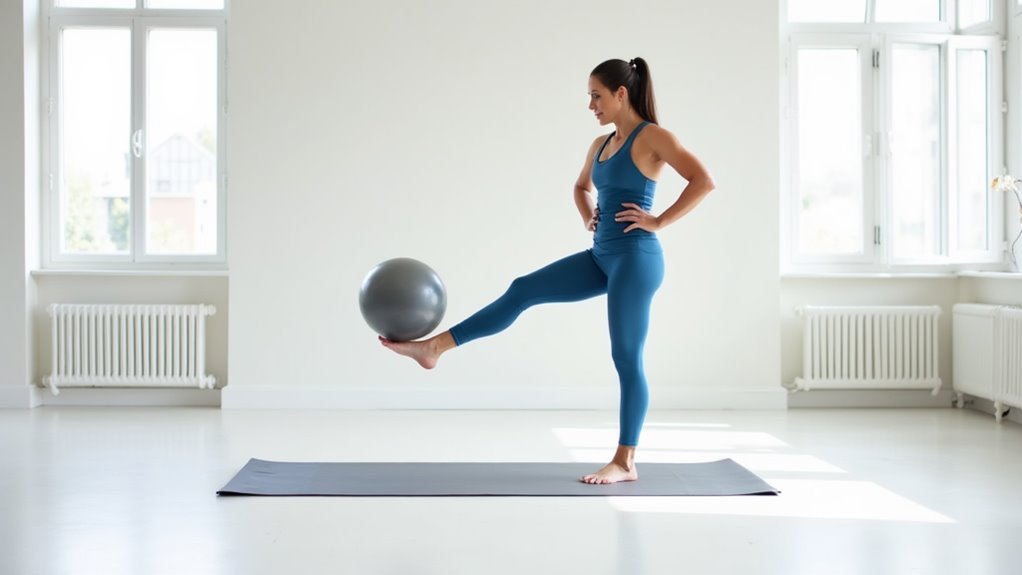
Strong lower body muscles serve as the foundation for comfortable high heel wear, helping you maintain better posture and balance throughout the day. Focus on exercises that target your glutes, hamstrings, and quads to build stability and strength for heel wearing.
Consider trying eco-friendly heel options that provide comfort while being sustainable for the environment.
| Exercise | Benefit for Heel Wearers |
|---|---|
| Squats | Improves overall stability |
| Bulgarian Split Squats | Enhances single-leg balance |
| Glute Bridges | Strengthens hip support |
| Walking Lunges | Develops dynamic stability |
| Calf Raises | Builds ankle strength |
Incorporate these exercises into your routine three times per week, starting with bodyweight movements before adding resistance. Remember to maintain proper form and gradually increase intensity as you build strength. You’ll notice improved comfort and endurance in heels as your lower body becomes stronger.
Plantar Fascia Care
You’ll need to understand how inflammation affects your plantar fascia to effectively treat heel pain from wearing high heels.
Using a tennis ball to roll under your foot can help break up tension and provide immediate relief from fascia discomfort.
Regular massage sessions, combined with proper stretching techniques, can significantly reduce your risk of developing chronic plantar fasciitis while wearing heels.
Finding supportive footwear options is essential for managing existing plantar fascia conditions while maintaining your style preferences.
Massage Techniques For Relief
While high heels can make a stunning fashion statement, they often lead to plantar fascia discomfort that requires targeted massage therapy for relief.
You’ll find significant improvement by implementing daily massage techniques that focus on breaking down adhesions and reducing inflammation.
- Sit in a figure-4 position and use your thumb to stroke from heel to toes for 5-7 minutes
- Roll a tennis ball or frozen water bottle under your foot for 7 minutes daily
- Perform firm circular motions with your thumbs when you notice specific pain points
- Massage across the width of your foot using varying pressure levels
- Work down the back of your calf toward the Achilles tendon
These techniques have shown an 85% success rate in reducing pain and improving mobility, especially when combined with proper stretching routines.
Understanding Fascia Inflammation
Living with plantar fasciitis requires a clear understanding of how this complex condition affects your feet. Despite its name suggesting inflammation, it’s actually a degenerative condition characterized by micro-tears and tissue breakdown in your plantar fascia.
You’ll likely experience sharp heel pain, particularly after periods of rest or first thing in the morning. This pain occurs because your fascia undergoes chronic stress and develops microscopic tears, leading to collagen disarray and tissue thickening.
While you might think you’re dealing with traditional inflammation, ultrasound studies show it’s more about tissue degeneration than inflammatory response.
Your foot structure, daily activities, and weight can all contribute to this condition. If you have high arches or flat feet, you’re particularly susceptible to developing plantar fasciitis due to altered biomechanics during walking.
Daily Foot Exercise Routine
To maintain healthy feet while wearing high heels regularly, a structured daily exercise routine can strengthen essential muscles and prevent common injuries.
You’ll want to focus on exercises that target your ankles, toes, and the intrinsic muscles of your feet. Start with basic movements and gradually progress to more challenging exercises as your strength improves.
- Perform ankle circles in both directions to enhance flexibility and joint mobility
- Practice short foot exercises to strengthen your arch and intrinsic foot muscles
- Include resisted big toe flexion using resistance bands for targeted toe strength
- Do heel raises on a slant board to build calf and midfoot strength
- Incorporate single-leg balance exercises to improve overall stability and control
These exercises, when performed consistently, will help you build the foundation needed for comfortable high heel wear.
Consider investing in comfort-focused heels while building your foot strength to minimize strain during the adjustment period.
Proper High Heel Form
Perfect posture and technique form the backbone of comfortable high heel wear. When walking in heels, keep your back straight, shoulders pulled back, and head held high.
Engage your core muscles while maintaining body alignment from head to toe.
Start with a manageable heel height of 6-7 cm and opt for wider heels if you’re a beginner.
Practice the heel-to-toe walking motion, taking small, controlled steps as if walking on an imaginary straight line.
Don’t rush – maintain a steady, slow pace with slightly bent knees.
Check your form in a mirror regularly and practice on carpeted surfaces before venturing outdoors.
You’ll build confidence faster by using shoe inserts for extra comfort and starting with shorter practice sessions at home.
For a polished professional look, consider investing in executive heels with superior arch support and cushioning.
Conclusion
Like a dancer preparing for the spotlight, you’ll need dedication to master these foot-strengthening exercises. By incorporating ankle stability training, targeted stretches, and proper form techniques into your daily routine, you’re building a solid foundation for comfortable high heel wear. Don’t forget to listen to your body’s signals and progress gradually. With consistent practice, you’ll stride confidently in your favorite heels.

